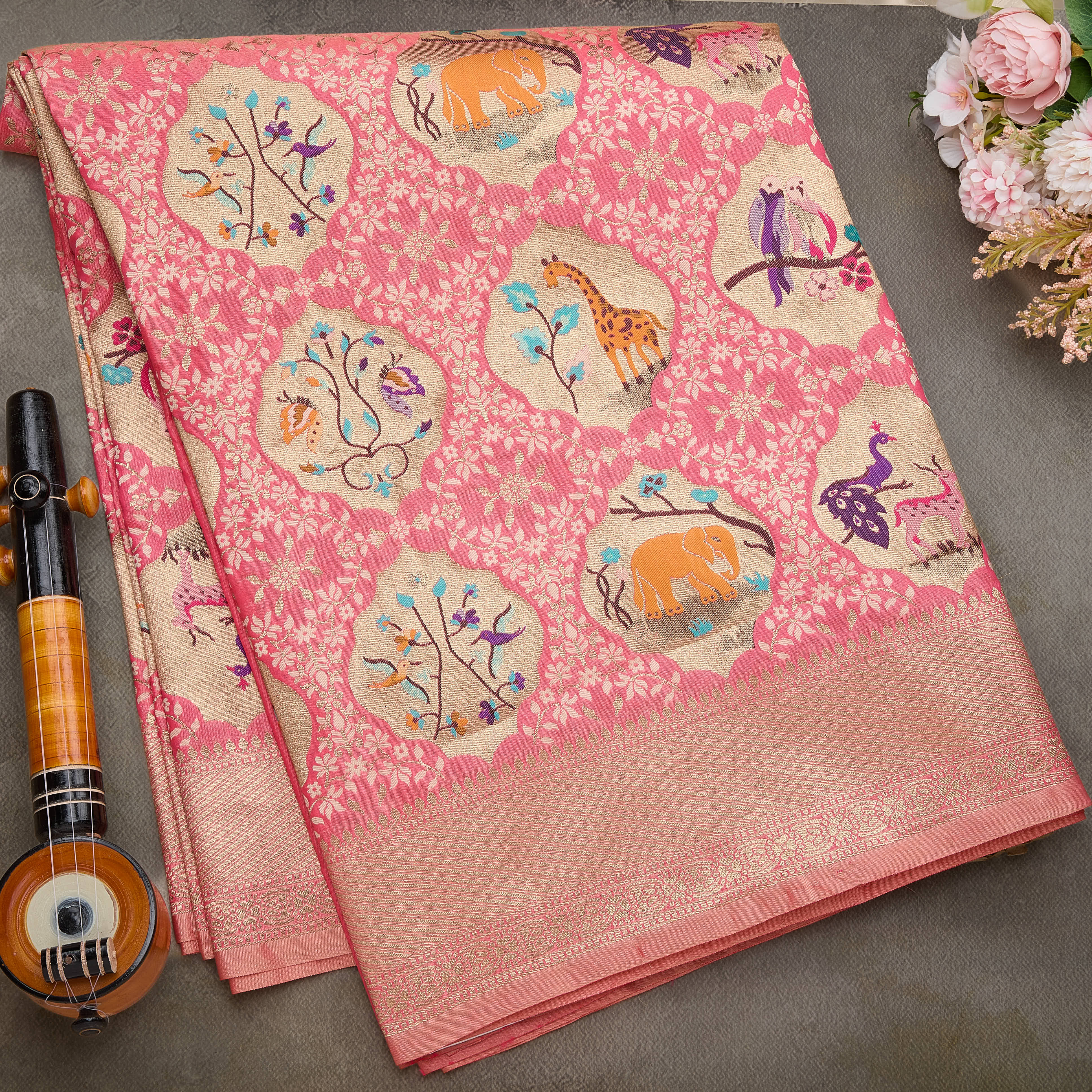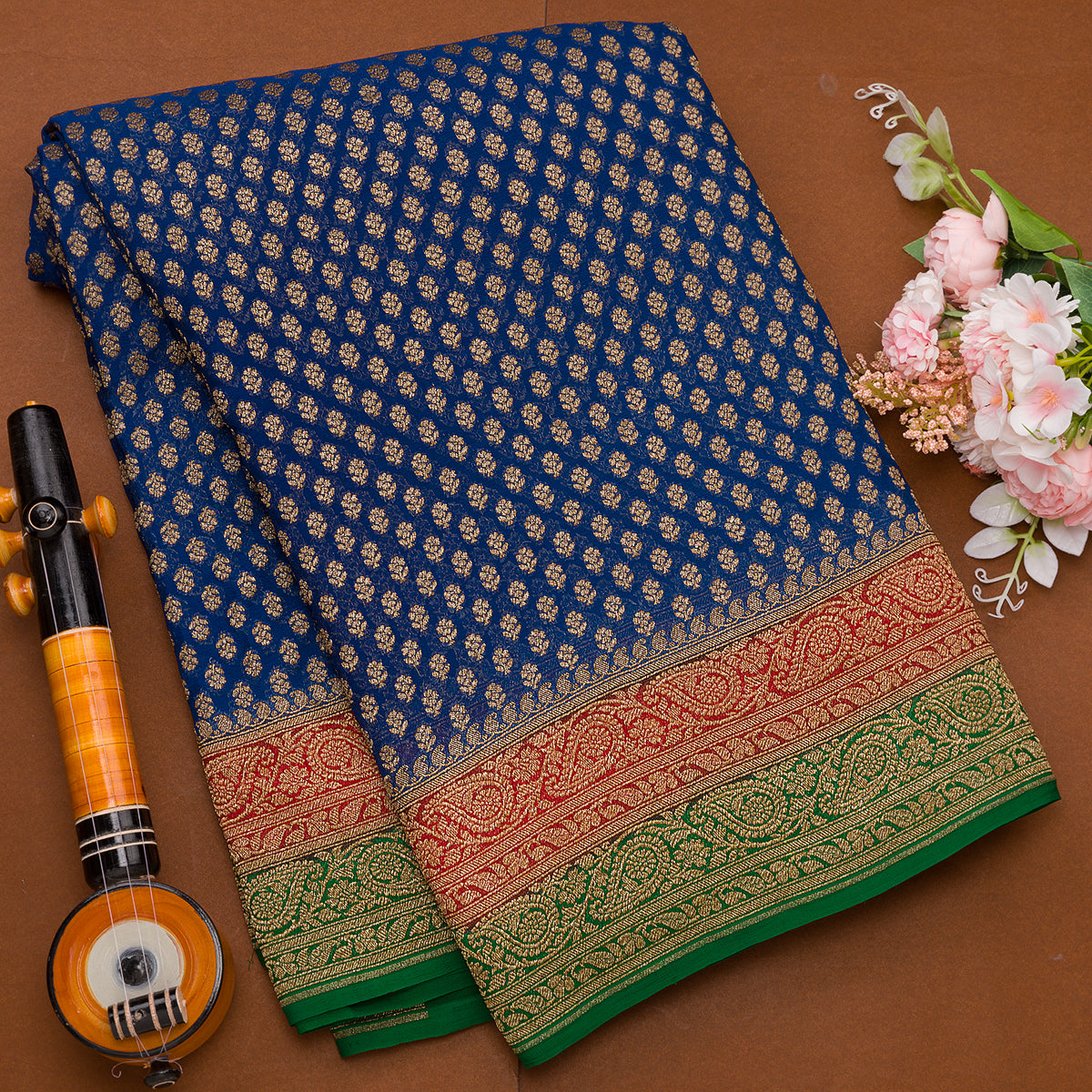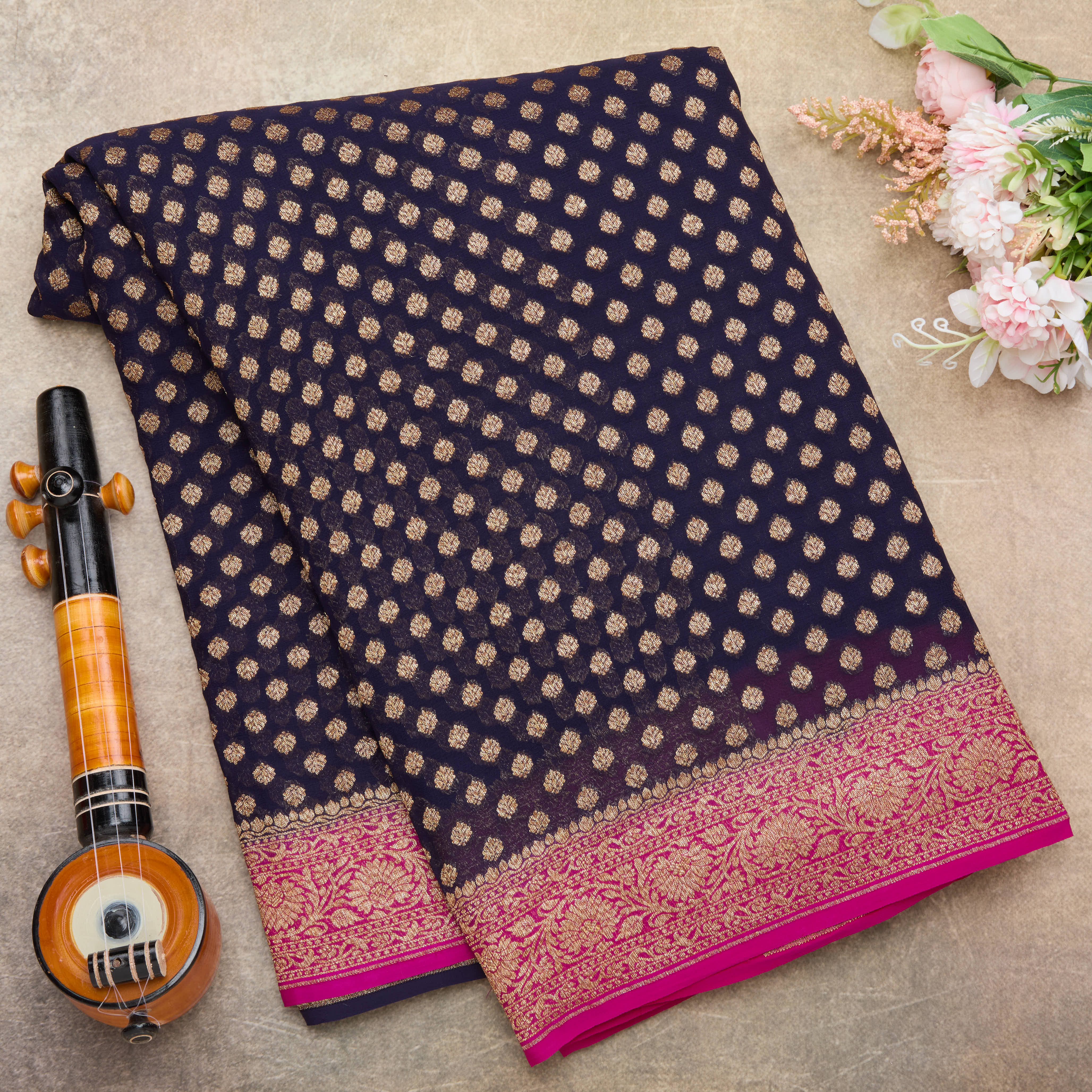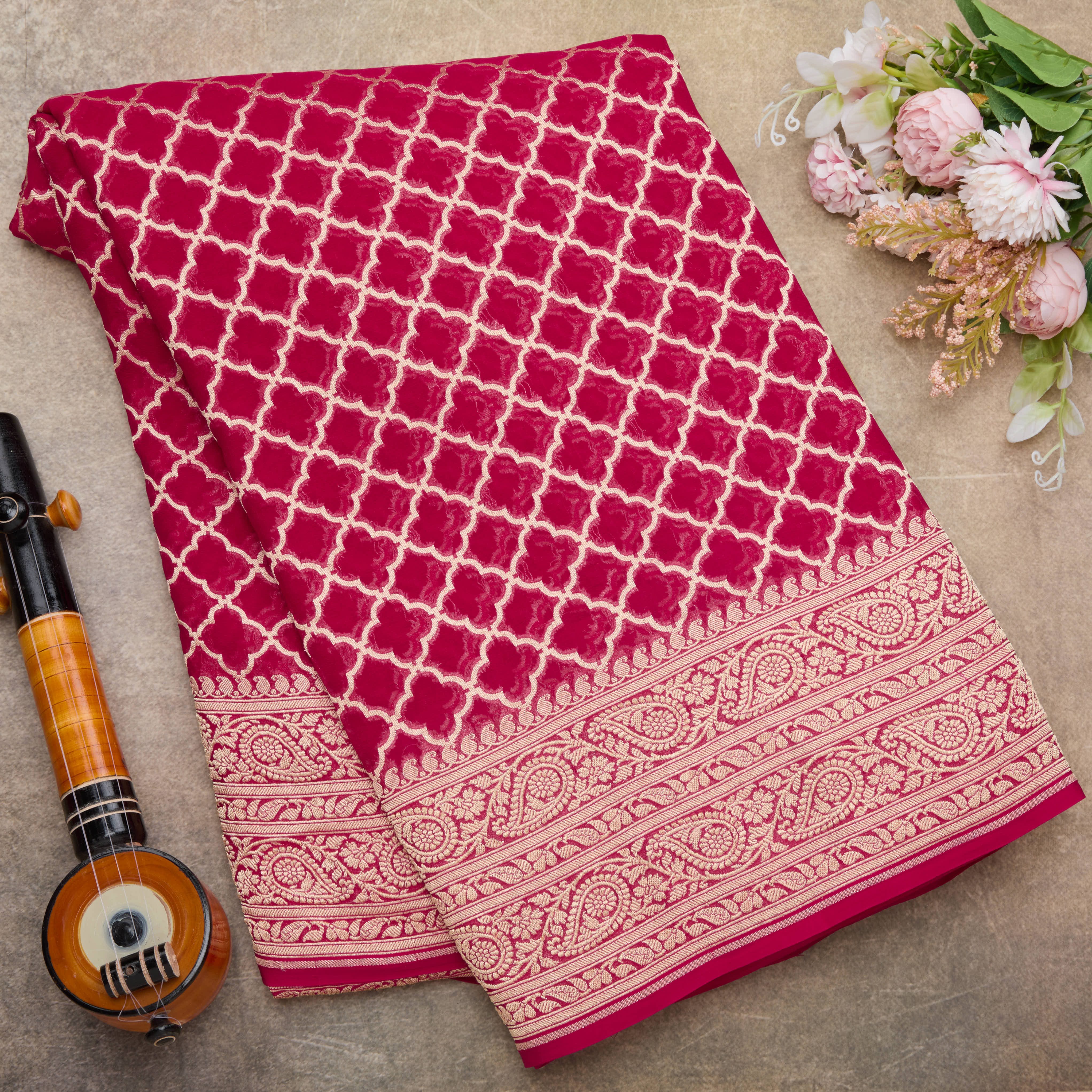Banarasi Silk Sarees for Every Occasion: Types and Styles You Should Know

Table of Contents
Banarasi silk sarees, woven with centuries-old craftsmanship, have long been a symbol of India’s rich textile heritage. Originating from the ancient city of Varanasi, these sarees are not just fabric; they are a masterpiece of art, history, and culture. Whether draped by brides or worn for festive occasions, the Banarasi silk saree holds a prominent place in the hearts of women across India. Known for their intricate designs, luxurious fabric, and rich history, these sarees are a treasure trove of various types and styles. But if you’ve ever wondered about the different types of Banarasi silk sarees, this guide will take you through the diverse and exquisite varieties that define this iconic garment.
The History Behind Banarasi Silk Sarees
Banarasi silk sarees have a deep historical connection to the Mughal period, with the art of weaving being perfected during the reign of Emperor Akbar in the 16th century. These sarees have evolved from the once simple designs to more intricate patterns, reflecting the fusion of Indian and Persian cultures. Today, Banarasi silk sarees are known for their opulence and are often passed down through generations, marking important milestones and celebrations. In case you’re unsure about which to pick, exploring the different types of Banarasi silk sarees will help you find one that suits your personal style.
1. Katan Banarasi Silk Saree
The Katan Banarasi silk saree is considered one of the finest types of Banarasi sarees. "Katan" refers to the plain weave technique used to craft these sarees, which ensures the fabric’s smooth and lustrous finish. These sarees are typically made from pure silk and are known for their exquisite feel and sheen. The Katan Banarasi silk sarees often feature elaborate motifs such as paisleys, florals, and intricate geometric patterns, making them ideal for weddings and grand celebrations. Due to their versatility, these sarees can be worn on both casual and formal occasions, combining elegance and timeless beauty.
For instance, a golden colour silk saree embodies the perfect blend of sophistication and tradition. The golden hue, often woven with zari or threadwork, gives the saree a regal appearance that stands out at any event. Whether it’s a subtle, understated shade of gold or a more dramatic, bright golden silk saree, these sarees are often worn at weddings and festive occasions.
2. Georgette Banarasi Silk Saree
Pure Banarasi georgette sarees are a lighter and more flowy version of the traditional silk sarees. The fabric is soft yet has a rich texture, making it comfortable to wear for extended periods. Georgette silk, with its sheer finish, allows for elegant draping while maintaining the opulent look associated with Banarasi sarees. These sarees feature delicate embroidery and subtle designs, making them an excellent choice for semi-formal events, family gatherings, or casual festive occasions. The lightweight nature of georgette makes this saree perfect for regions with warmer climates as well.
3. Banarasi Brocade Saree
Brocade is a style of fabric that features a raised pattern woven into the material, often with gold or silver thread. Banarasi brocade sarees are renowned for their opulence and grandeur. These sarees are made with silk threads, and intricate designs of flowers, birds, and Mughal-inspired motifs are woven into the fabric using zari (gold or silver thread). These sarees exude a royal charm and are perfect for weddings, special ceremonies, or festivals. The heavy embellishments on the brocade sarees make them a popular choice for brides and bridesmaids who want to make a statement. A Banarasi soft silk saree is a great option if you desire traditional beauty with comfort.
4. Tissue Banarasi Silk Saree
While each of the types of Banarasi silk sarees features unique weaving techniques and embellishments, tissue Banarasi silk sarees are made from a finer type of silk thread that gives them a crisp and metallic sheen. The term “tissue” refers to the thin, lightweight nature of the fabric, which allows it to drape beautifully while maintaining its regal look. These sarees often feature minimal yet elegant motifs and zari work, making them an excellent choice for brides who prefer subtlety over excessive embellishment. The light and airy fabric makes the tissue Banarasi silk saree a popular choice for day-time events, such as engagements and receptions.
5. Banarasi Shattir Silk Saree
Shattir silk sarees are a unique variation of Banarasi silk, characterized by a soft, matte finish that contrasts with the traditional shine of other silk varieties. Shattir silk is often used to create sarees that have a slightly heavier drape. The designs on Shattir sarees are typically bold and dramatic, featuring vibrant colors and distinct patterns. These sarees are a popular choice for women who want to make a bold statement at festive gatherings or formal events. The weight and texture of the fabric add to its grandeur, making it one of the more regal types of Banarasi silk sarees.
6. Banarasi Jamdani Silk Saree
The Banarasi Jamdani silk saree is known for its fine handloom weaving technique that has been passed down for generations. Unlike other Banarasi sarees, Jamdani sarees do not have zari work but instead feature intricate motifs that are woven directly into the fabric. These sarees are often light and airy, with delicate geometric patterns or floral motifs scattered across the length of the saree. The Jamdani technique allows for a more fluid and flexible drape, making it an ideal choice for women who prefer a softer, more breathable fabric. This saree is a stunning option for any celebration that calls for understated elegance and artistry.
7. Banarasi Silk Sarees with Resham Work
Resham is a type of silk thread used to create intricate designs, similar to zari but with a softer finish. Banarasi silk sarees with resham work are known for their subtle elegance. The resham threads are used to weave delicate floral and paisley motifs, creating a refined and understated look. These sarees often come in pastel shades or soft metallic hues, making them a perfect choice for women who want to celebrate an occasion without overwhelming the eyes with heavy embellishments. The light, airy fabric and the subtle sheen of resham make this type of saree a timeless addition to any wardrobe. For a flawless look at your next celebration, mastering how to drape a red Banarasi silk saree might also be essential to showcase its rich texture and intricate design.
Takeaway
Banarasi silk sarees are not just garments; they are woven stories, cultural symbols, and historical treasures that showcase India’s rich textile heritage. Each type of Banarasi silk saree, from the regal brocades to the delicate georgettes, holds a unique charm that makes it perfect for different occasions. Whether you prefer the heavy grandeur of Katan or the airy elegance of Georgette, learning about the types of Banarasi silk sarees can guide your purchase. While Banarasi silk sarees capture the timeless elegance of Varanasi’s rich weaving traditions, many also admire the bold vibrancy of a Kanjivaram silk saree, which stands as a testament to South Indian craftsmanship and offers a distinct alternative for those seeking a different style. So, the next time you choose to wear a Banarasi silk saree, remember that you are not just donning fabric, but a piece of India’s artistic legacy that continues to dazzle and inspire.







